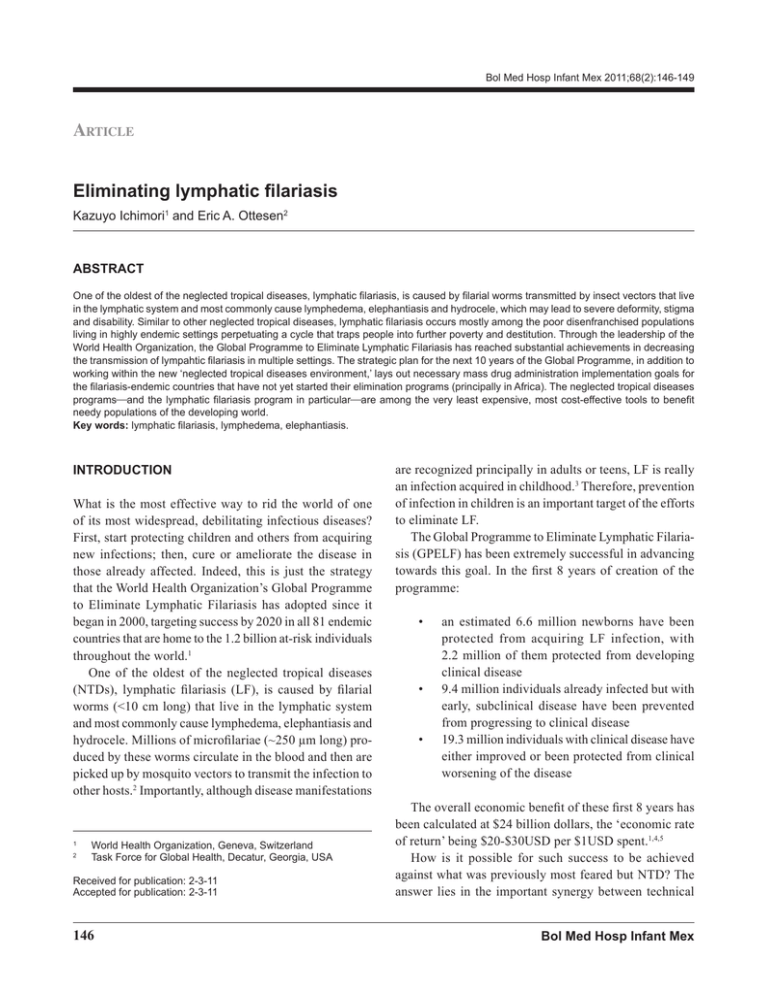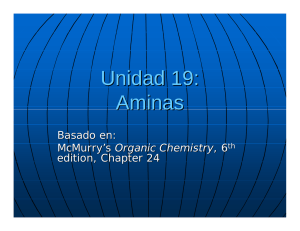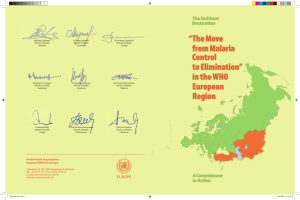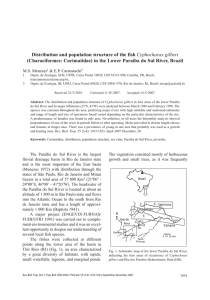Eliminating lymphatic filariasis
Anuncio

Bol Med Hosp Infant Mex 2011;68(2):146-149 Article Eliminating lymphatic filariasis Kazuyo Ichimori1 and Eric A. Ottesen2 ABSTRACT One of the oldest of the neglected tropical diseases, lymphatic filariasis, is caused by filarial worms transmitted by insect vectors that live in the lymphatic system and most commonly cause lymphedema, elephantiasis and hydrocele, which may lead to severe deformity, stigma and disability. Similar to other neglected tropical diseases, lymphatic filariasis occurs mostly among the poor disenfranchised populations living in highly endemic settings perpetuating a cycle that traps people into further poverty and destitution. Through the leadership of the World Health Organization, the Global Programme to Eliminate Lymphatic Filariasis has reached substantial achievements in decreasing the transmission of lympahtic filariasis in multiple settings. The strategic plan for the next 10 years of the Global Programme, in addition to working within the new ‘neglected tropical diseases environment,’ lays out necessary mass drug administration implementation goals for the filariasis-endemic countries that have not yet started their elimination programs (principally in Africa). The neglected tropical diseases programsand the lymphatic filariasis program in particularare among the very least expensive, most cost-effective tools to benefit needy populations of the developing world. Key words: lymphatic filariasis, lymphedema, elephantiasis. INTRODUCTION What is the most effective way to rid the world of one of its most widespread, debilitating infectious diseases? First, start protecting children and others from acquiring new infections; then, cure or ameliorate the disease in those already affected. Indeed, this is just the strategy that the World Health Organization’s Global Programme to Eliminate Lymphatic Filariasis has adopted since it began in 2000, targeting success by 2020 in all 81 endemic countries that are home to the 1.2 billion at-risk individuals throughout the world.1 One of the oldest of the neglected tropical diseases (NTDs), lymphatic filariasis (LF), is caused by filarial worms (<10 cm long) that live in the lymphatic system and most commonly cause lymphedema, elephantiasis and hydrocele. Millions of microfilariae (~250 µm long) produced by these worms circulate in the blood and then are picked up by mosquito vectors to transmit the infection to other hosts.2 Importantly, although disease manifestations 1 2 World Health Organization, Geneva, Switzerland Task Force for Global Health, Decatur, Georgia, USA Received for publication: 2-3-11 Accepted for publication: 2-3-11 146 are recognized principally in adults or teens, LF is really an infection acquired in childhood.3 Therefore, prevention of infection in children is an important target of the efforts to eliminate LF. The Global Programme to Eliminate Lymphatic Filariasis (GPELF) has been extremely successful in advancing towards this goal. In the first 8 years of creation of the programme: • • • an estimated 6.6 million newborns have been protected from acquiring LF infection, with 2.2 million of them protected from developing clinical disease 9.4 million individuals already infected but with early, subclinical disease have been prevented from progressing to clinical disease 19.3 million individuals with clinical disease have either improved or been protected from clinical worsening of the disease The overall economic benefit of these first 8 years has been calculated at $24 billion dollars, the ‘economic rate of return’ being $20-$30USD per $1USD spent.1,4,5 How is it possible for such success to be achieved against what was previously most feared but NTD? The answer lies in the important synergy between technical Bol Med Hosp Infant Mex Eliminating lymphatic filariasis advances and public health partnerships, specifically the following elements: • • • • • • The strategy developed by the GPELF is simple, safe and effectiveMass Drug Administration (MDA) of a single two-drug regimen (albendazole + either ivermectin or diethylcarbamazine [DEC]) given once yearly to entire at-risk populations for 4-6 years.6 Past programmatic experiences provide important lessons from successful LF elimination efforts (including from the Americas in Trinidad/Tobago and regions of Brazil) using similar populationbased strategies. An essential diagnostic toolhighly sensitive, specific antigen detection in a field-ready, rapidassay formathas been developed that can provide for the needs of both initial mapping and subsequent monitoring of program progress.7 A resolution by the World Health Assembly in 1997, recognizing the potential effectiveness of partners working together, called upon Member States “to take advantage of recent advances in the understanding of lymphatic filariasis and the new opportunities for its elimination by developing national plans leading to its elimination…”1 Extraordinarily generous donations of all three drugswhatever is required to reach the Programme’s goalhave been made, first in 1998 by GlaxoSmithKline (albendazole) and Merck and Co., Inc. (ivermectin [Mectizan®]) and, most recently in 2010, by Eisai, Inc. (DEC).8,9 National commitment and community enthusiasm (evidenced by literally hundreds of thousands of participating volunteers) have ensured the very high levels of population compliance with the MDA needed for successful LF elimination. It is because these key pieces of the puzzlestrategy, tools, national commitment and essential drugshad come together effectively, and because the value of successfully targeting this disease (earlier identified as one of the world’s leading causes of permanent or long-term disability) was recognized that initial funding to implement the GPELF was provided by a number of concerned bilateral aid agencies (governments of the UK, Japan and U.S.) and Vol. 68, Marzo-Abril 2011 foundations (Bill & Melinda Gates Foundation, Arab Fund for Economic and Social Development). As a result, by the end of 2009, 2.8 billion doses of medicine had been administered to a cumulative targeted population of 845 million individuals in 53/81 endemic countries! Indeed, of these 53 countries, 29 have achieved full geographic coverage and 20 have already completed five or more rounds of MDA in all endemic areas. Without question, the GPELF has been one of the most rapidly expanding global health programs in the history of public health.1 During its first 6 years the GPELF was implemented primarily as a stand-alone program in the targeted countries, not with central funding but rather relying on a patchwork of local and international contributions. Despite the Programme’s global health success, however, and the strong support it had from affected communities and its early donors, identifying sufficient implementation funds to target this disease of the most disenfranchised, ‘invisible’ sectors of society became more and more problematic. Fortunately, at this same time, efforts by the WHO and others were helping the international community become increasingly aware of the enormous impact, both social and economic, that a group of generally unheralded infections was having on the developing world.10 These diseases of povertyand perpetuators of povertywere given the moniker ‘neglected tropical diseases.’ Of these NTDs and the public health approach to them, seven (including LF) share specific key elements; they all occur in the most marginalized populations, have had little attention paid to them in the past, and can be effectively treated with onceyearly, single-dose regimens of drugs that are available, safe and inexpensive (or donated free). Indeed, because of these and other similarities, the ‘integrated’ control of these NTDs is currently being advocated and supported. Not surprisingly, the GPELF with its 10-year experience of program implementation in so many of the countries and populations endemic for the NTDs has become a core element of integrated programs targeting them. Also, not surprisingly, the recently revised strategic plan for the GPELF now envisions its LF elimination efforts wholly linked with the broader efforts to control all seven of the NTDs targeted with a similar ‘preventive chemotherapy’ (PCT) strategy.1 The strategic plan for the next 10 years of the GPELF, in addition to working within the new ‘NTD environment’ and laying out necessary MDA implementation goals 147 Kazuyo Ichimori and Eric A. Ottesen for the LF-endemic countries that have not yet started their elimination programs (principally in Africa), also targets more vigorously the second key element of the LF elimination programcuring or ameliorating the clinical manifestations of LF in those already affected.1 Pioneering studies (especially in Brazil) have led to new understandings of the pathogenesis, optimal management and preventive measures for filarial lymphedema, elephantiasis and hydrocele.11 Relatively simple, inexpensive, often self-administered measures can entirely transform the debilitation, depression and resignation of affected patients to an outlook of hopefulness, effectiveness and re-engagement. Because only 1/3 of the LF-endemic countries initiated specific morbidity management programs during the first 10 years of the GPELF, it is essential that these programs be extended to all countries and all affected populations if the GPELF is to achieve its LF elimination goals by 2020. Fortunately, however, because the principles underlying the management of LF morbidity are very similar to those for other causes of chronic lymphedema and for wound management (e.g., diabetes, Buruli ulcer, etc.), a strategy for integrated morbidity management is now being developed to expand the reach of current LF morbidity care.12 The horizon for the next 10 years of the GPELF presents other challenges as well. After national LF programs complete the yearly MDA phase they must confirm the successful LF elimination and then undertake appropriate surveillance to ensure that LF does not re-emerge. Fortunately, the Gates Foundation has provided support for the operational research needed to define the best tools and strategies to implement appropriate monitoring, evaluation and surveillance, with the result that WHO has been able to develop the necessary guidelines for the national programs.13 Importantly also, the principles underlying these guidelines are very similar to those for the other NTD programs currently being ‘integrated’ with the LF program, so shared experiences, not only among the national LF programs but also among all programs targeting the related NTDs, should promote the operational effectiveness of all these global initiatives. Most essential for the continued success of the GPELF, however, remains the one prerequisite for all successful global health initiativesenduring partnership. Global health endeavors are so complex that multiple organizations working together are required at every level of 148 activity. From the broadest perspective, the national commitment to program implementation and success is absolutely necessary, but there must also be agencies able to fund implementation of these programs that focus on diseases of the most needy, but least vocal, sectors of the developing world as well as organizations ready to support the operational (implementation) research needed to overcome programmatic technical barriers. Furthermore, opportunities available for new partnerships must also be pursued, particularly with other health initiatives that can be complementary in targeting vectors common to both the NTDs and other important diseases such as malaria.1 The NTD programsand the LF program in particularare among the very least expensive, most cost-effective tools to benefit needy populations of the developing world, especially because of their extraordinary partnerships with the private sector that have made some of the world’s most valuable drugs available at no cost for these programs.8 As the GPELF has proven, huge numbers of needy (and grateful) people can be treated both rapidly and effectively if even a small amount of funding is available for program implementation. In these times of international financial uncertainty when the temptation is ever-present to withdraw funding from programs targeting ‘unseen’ populations, it becomes all the more important to remember that the scourge of LF, both social and economic, can be eliminatedindeed, is on track to be eliminatedand that only through continued support can we guarantee that the GPELF can achieve its lofty goal to benefit all affected peoples by 2020. Correspondence: Eric A. Ottesen, MD, AB Task Force for Global Health Decatur, Georgia E-mail: eottesen@taskforce.org REFERENCES 1. 2. 3. World Health Organization. Global Programme to Eliminate Lymphatic Filariasis. Progress report 2000-2009 and strategic plan 2010-2020: halfway towards eliminating lymphatic filariasis. Geneva: World Health Organization; 2010. Contract No.: WHO/HTM/NTD/PCT/2010.6. Ottesen EA. Lymphatic filariasis: treatment, control and elimination. Adv Parasitol 2006;61:395-441. Witt C, Ottesen EA. Lymphatic filariasis: an infection of childhood. Trop Med Int Health 2001;6:582-606. Bol Med Hosp Infant Mex Eliminating lymphatic filariasis 4. 5. 6. 7. 8. Ottesen EA, Hooper PJ, Bradley M, Biswas G. The global programme to eliminate lymphatic filariasis: health impact after 8 years. PLoS Negl Trop Dis 2008;2:e317. Chu BK, Hooper PJ, Bradley MH, McFarland DA, Ottesen EA. The economic benefits resulting from the first 8 years of the Global Programme to Eliminate Lymphatic Filariasis (20002007). PLoS Negl Trop Dis 2010;4:e708. Gyapong JO, Kumaraswami V, Biswas G, Ottesen EA. Treatment strategies underpinning the global programme to eliminate lymphatic filariasis. Expert Opin Pharmacother 2005;6:179-200. Weil GJ, Lammie PJ, Weiss N. The ICT filariasis test: a rapidformat antigen test for diagnosis of bancroftian filariasis. Parasitol Today 1997;13:401-404. Gustavsen KM, Bradley MH, Wright AL. GlaxoSmithKline and Merck: private-sector collaboration for the elimination of lymphatic filariasis. Ann Trop Med Parasitol 2009;103(suppl1):S11-S15. Vol. 68, Marzo-Abril 2011 9. 10. 11. 12. 13. Eisai Public Relations Department. Eisai to provide medicine to help World Health Organization (WHO) combat lymphatic filariasis epidemic; 2010. Available at: http://www.eisai.co.jp/ enews/enews201066.html. Fenwick A, Molyneux D, Nantulya V. Achieving the millennium development goals. Lancet 2005;365:1029-1030. Dreyer G, Addiss D, Dreyer P, Noroes J. Basic lymphedema management: treatment and prevention of problems associated with lymphatic filariasis. Hollis, NH: Hollis Publishing Company; 2002. Brantus P. Ten years of managing the clinical manifestations and disabilities of lymphatic filariasis. Ann Trop Med Parasitol 2009;103(suppl 1):S5-S10. World Health Organization. Monitoring and epidemiological assessment of mass drug administration in the programme to eliminate lymphatic filariasis. Geneva: World Health Organization. 2011, in press. Contract No.: WHO/HTM/ NTD/2011.xx. 149


